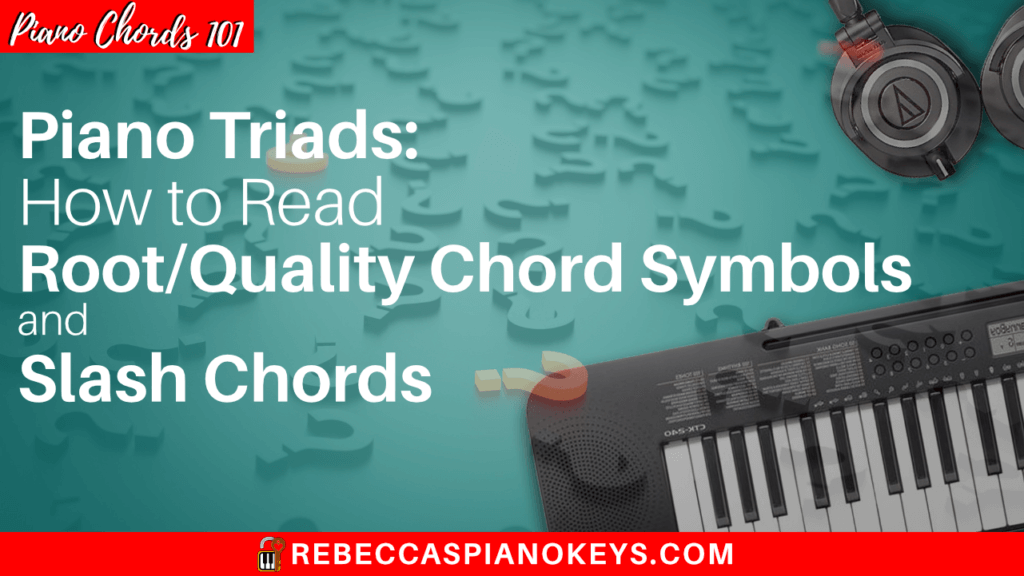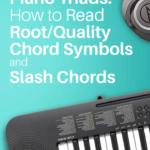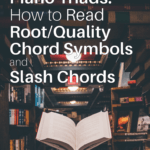Last Updated on July 10, 2022 by Rebecca
Disclosure: Please note that this article contains affiliate links, and that means that I may earn a commission if you buy something through my links. Read my full disclaimer here.
With all the different symbols and systems out there, learning to read chord symbols can be a real challenge for beginners. The best place to start? Learn to understand root/quality chord symbols for triads and their inversions!
Understanding how to read chord symbols is incredibly important for anyone who wants to play pop music. Chord symbols allow you to learn songs from lead sheet and chord charts, and you'll often also see chord symbols on fully notated sheet music to help musicians recognize the chord structure of a song.
But chord symbols are useful for so much more than just pop music!
A solid understanding of chord symbols is crucial if you want to be able to create your own music! Partly because you'll want some way of writing down your music, but also because many of the resources that can teach you how to create your own music require that you already understand chord symbols.
Now, the first thing you need to know when starting to learn how to read chord symbols is that there are actually 3 different kinds of chord symbols. They're like 3 different languages, each with their own unique ways of representing the exact same chords.
So the first thing you need to do is decide which types of chord symbols you want to learn to read!
The 3 Types of Musical Chord Symbols
The 3 types of of chord symbols are:
- Root/Quality Chord Symbols
- Jazz Chord Symbols
- Functional Chord Symbols
This post will teach you about root/quality chord symbols for the 4 different types of triads, and their inversions.
No time to read now? Pin it for later!

Which Chord Symbols You Should Learn to Read First
As a beginner, root/quality chord symbols are what you should learn first.
You'll need a basic understanding of root/quality chord symbols (at least for triads) in order to understand jazz chord symbols. They're very similar in a lot of ways, but also very different in other ways. And functional chord symbols will likely confuse you if you don't already have a basic understanding of root/quality chord symbols.
As for what you should learn after root/quality chord symbols, that's entirely up to you. It depends what kind of music you want to play, and what skills you want to develop.
If you want to learn to play jazz music, then, obviously, you should learn jazz chord symbols next.
If you want to play pop music or classical music (or modern classical music), or if you want the ability to learn a song in one key then easily transpose it into any other key, you'll want to learn functional chord symbols next.
Root/Quality Chord Symbols
As the name suggests, there are 2 part of a root/quality chord symbol. The first part identifies the root of the chord, and the second part identifies the quality of the chord.

What Is the Root of a Chord?
The root of a chord is the note the chord is built on. All the other notes in the chord are determined relative to the root of the chord.
In root/quality chord symbols, the root of a chord is indicated by a capital letter. This is the first part of the chord symbol.
In the example above, (C, Cm, C°, C+) all four of the chords have the same root (C) but a different quality.
You can build a chord on any note, therefore any note of the musical alphabet can be the root of a chord. You can have a C chord, a B chord, an F# chord, an Eb chord, etc.
What Is the Quality of a Chord?
The quality of a chord describes the type of sound the chord creates, and the relationships between the different notes of the chord. The more notes in a chord, the greater the amount of qualities possible for that chord.
In root/quality chord symbols, the quality of a chord is indicated by either a lower-case letter or a symbol that is placed after the capital letter that indicates the root of the chord.

For triads, there are only 4 possible qualities: major, minor, diminished, and augmented.
The major triad is considered the default triad. For this reason, a major triad is indicated only by the capital letter identifying its root. There is no extra symbol added after the root letter. For example:
- C = C major triad
- E = E major triad
- F# = F# major triad
- Ab = Ab major triad
A minor triad is indicated by a lower-case m. For example:
- Dm = D minor triad
- Fm = F minor triad
- C#m = C# minor triad
- Ebm = Eb minor triad
A diminished triad is indicated by a ° symbol or the abbreviation dim. For example:
- B° or Bdim = B diminished triad
- C° or Cdim = C diminished triad
- G#° or G#dim = G# diminished triad
- Db° or Dbdim = Db diminished triad
An augmented triad is indicated by a + symbol or the abbreviation aug. For example:
- C+ or Caug = C augmented triad
- A+ or Aaug= A augmented triad
- D#+ or D#aug= D# augmented triad
- Bb+ of Bbaug= Bb augmented triad
*Sometimes you'll see the + symbol printed as a superscript, and sometimes you'll see it printed as a full-sized symbol. Both options are accepted.

Chord Inversions
A chord's default position is called root position. This means the chord is arranged so that the root note is also the bass note.
To create a chord inversion, you take the bottom note of the chord and move it up to the top of the chord. Doing this rearranges the notes of the chord so that a new note becomes the bass note.
If you do this once, you create a 1st inversion chord. You've inverted the chord (bottom note moved to top) once.
If you do this twice, you create a 2nd inversion chord. First, you took the root position triad and inverted it. Then, you took the 1st inversion triad and inverted it. You inverted the chord twice to create a 2nd inversion triad.
Take a look at the diagram below to see what a C major triad looks like in root position, 1st inversion, and 2nd inversion.

In the root position triad, the root (C) is also the bass note.
In the 1st inversion triad, the root (C) is moved to the top. Now E is the bass note.
In the 2nd inversion triad, the root (C) is moved to the top to create the 1st inversion triad, then the E is moved to the top to create the 2nd inversion triad. Now G is the bass note.
Root Note vs. Bass Note
Before we go any further, it is very important to make sure you understand that the root of a chord, and the bass note of a chord are 2 very different things!
In fact, it's so important, that I'll say it again in bold.
The terms root and bass mean 2 very different things!
When you first start learning chords, you usually learn them in root position. And in root position, the root note is always the bass note of the chord. So it's common for beginners to mistakenly think the term “root note” means “bass note” or “lowest note of the chord.”
This is not the case!
As mentioned above, the root note is the note the chord is built on. It's the identity of the chord. It never changes no matter how you arrange the notes of the chord.
The bass note is the lowest note of the chord. This changes depending on how you invert the chord.
A C major triad is still a C major triad, no matter whether the bass note is C, E or G.
Think of it like getting dressed in the morning. Your name is who you are (your root note); your outfit is how you're choosing to present yourself to the world today (your bass note). Your name stays the same, no matter how you dress yourself for the day.

Root/Quality Chord Inversion Symbols (Slash Chords)
As discussed above, each inversion of a chord has a new bass note.
In root/quality chord symbols, chord inversions are indicated by slash chords.
A slash chord consists of 2 parts: the root/quality symbol before the slash, and the bass note after the slash. For example:
- C/E = C major triad, with E in the bass
- Dm/A = D minor triad, with A in the bass
- F#°/C = F# diminished triad, with C in the bass
- Eb+/G = Eb diminished triad, with G in the bass
When you say a slash chord out loud, you say the word “over” to indicate the slash. For example:
- C/E = C over E
- Dm/A = D minor over A
- F#°/C = F sharp diminished over C
- Eb+/G = E flat diminished over G
However, slash chords aren't only used to represent inverted chords.
Sometimes the bass note indicated in a slash chord is not a chord-tone (meaning it's not a note that is part of the indicated chord).
For example, a C major triad includes the notes C, E, and G. But you could have a C/B slash chord, or a C/F# slash chord, or literally any other note indicated as the bass note.
The table below shows 4 examples of slash chords, and illustrates what each part of the symbol means. Think about each chord and see if you can answer the following questions:
- Which chord is in 1st inversion?
- Which chords are in 2nd inversion?
- Which chord has a non-chord tone in the bass?

Getting Creative with Chord Inversions
You may not realize this, but the only determining factor of a chord's inversion is its bass note.
When we first learn about inversions, we're taught to take the bass note and move it up an octave. As beginners, we're led to believe there is only 1 possible way to configure a root position triad, only 1 possible way to configure a 1st inversion triad, and only 1 possible way to configure a 2nd inversion triad.
But the truth is, this is just not true!
There are actually so many more possibilities. It's just that most music curricula save these other possibilities for more advanced studies, and many students never make it that far.
So what are all these other possibilities?
Basically, you can do just about anything you want. If you're playing the notes of the C major triad, and the lowest note is an E, you are playing a C major chord in 1st inversion, or a C/E chord.
Take a look at the following diagram as an example of 4 different ways you could play a C/E chord. In each example, the notes played are some combination of C, E, and G (the notes of the C major triad), and the bass note is E.

*These 4 examples are by no means the only 4 ways to play a C/E chord! Play around and see how many other ways you can arrange the notes to create a C/E chord!
Free Root/Quality Triad Chord Symbols Cheat Sheet
If you need a quick and easy way to remember all of this, I've created a 1-page printable you can use as a reference guide. The printable includes 4 of the diagrams from this page, along with brief explanations to accompany them.



